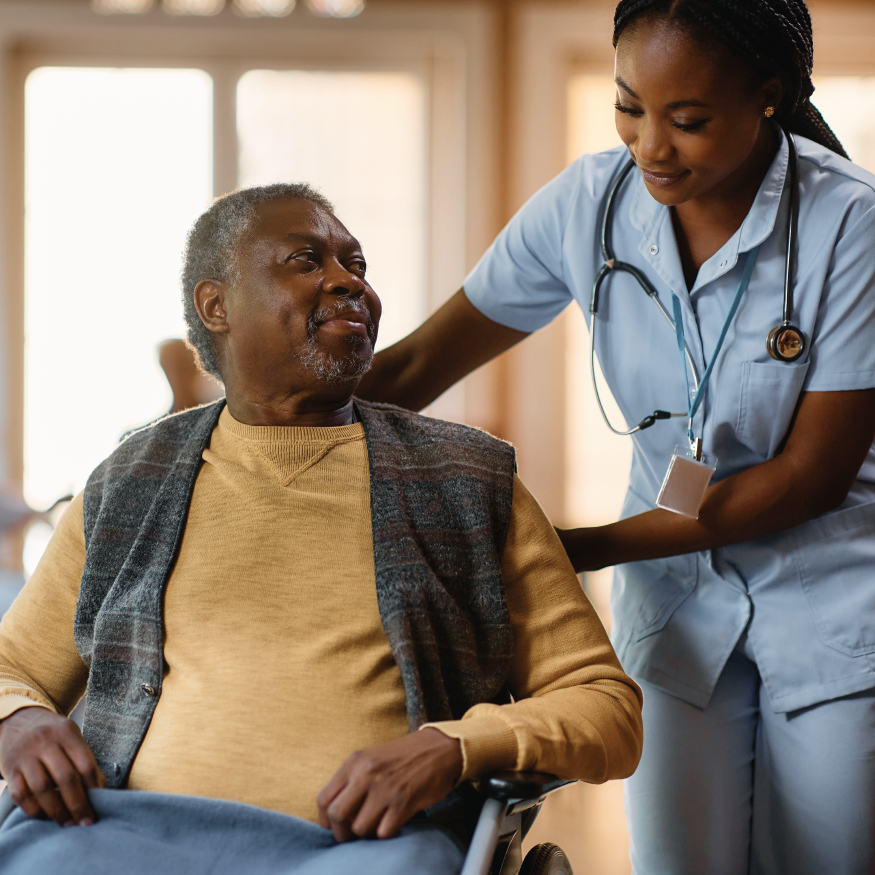
For Patients & Families
We’re here to help you make important care decisions
Is hospice care the right choice for you or your loved one? Learn about hospice, how to start the conversation, becoming a caregiver, volunteering for hospice, and more.
When is it time for hospice care?
Hospice care is medical care focused on the patient’s quality of life when curative options have been exhausted. It is most beneficial when care begins early, even months before death is expected.
Treatment is no longer effective or desired
Medical treatments aren’t working or have become too taxing, and life expectancy is 6 months or less.
Health has declined significantly
Pain or other symptoms have increased, there is substantial weight loss, extreme fatigue, shortness of breath, or weakness.
Quality of life is now the primary focus
Being comfortable in familiar surroundings with family, friends, pets, and belongings is the goal.
If you think it may be time for hospice, start here.
If you’re not sure, browse the information below or ask a hospice expert.

What is hospice?
Hospice provides something more for patients when a cure is not possible. It is medical care focused on providing comfort for people with a life expectancy of six months or less when symptom management and quality of life are the primary goals.
- Hospice care is person-centered. It is most often delivered where the patient resides by a team of professionals trained to address the patient’s physical, psychosocial, and spiritual needs. It also provides support to families and unpaid caregivers.
- Hospice care is a Medicare benefit. All Medicare and Medicare Advantage enrollees have a right to hospice care.
- Hospice care is not 24/7 bedside care. It does not replace nursing home care, and it does not hasten death.

Starting the conversation
Talking about end-of-life care can be uncomfortable. But to ensure that you or your loved one receives the best care, it is important to explore the available options and discuss care preferences before significant physical or cognitive impairments prevent the conversation from taking place.
- Talk openly with healthcare professionals to learn about the likely course of the patient’s condition and all available care options.
- Discuss options and preferences for medical interventions, where the patient wants to be when they die, and who will be designated as the medical decision maker.
- Remember that personal and cultural history, including faith beliefs, may influence care decisions, and multiple conversations may need to occur.

Accessing hospice care
Early admission to hospice gives both the patient and family caregivers more time to take advantage of the benefits hospice provides. A physician’s referral can start the process, or you can make a self-referral.
- Start the hospice conversation with healthcare professionals and the patient early.
- Get recommendations for hospice providers, assess them, and make an informed decision.
- Once a decision has been made, expect the provider to conduct an admissions eligibility assessment.

Preparing for hospice care
The hospice team consists of a registered nurse, hospice aide, social worker, chaplain or spiritual counselor, nurse practitioner or physician assistant, medical doctor, and volunteers. In the first days and weeks of receiving hospice care at home, the team will:
- Develop a comprehensive, personalized care plan structured to meet the patient’s immediate and future medical, physical, spiritual, and psychosocial needs.
- Provide family caregivers with education and instructions for providing care properly and safely.
- Order equipment, supplies, and medications to be delivered.
- Begin routine visits by the registered nurse and hospice aides.

Caring for loved ones
Whether you’re a family member or friend, providing care to a hospice patient can be a rewarding experience — and a difficult one. This crucial role requires flexibility and adaptability as the needs of the patient change. As a caregiver, it is important to know how best to care for the patient and for yourself.
- Caregivers provide companionship; they help with eating and drinking, physical activity and personal care, shopping, caring for pets, and so much more.
- The hospice team is available to provide education, guidance, and support as needed.
- As a caregiver, it is important to know when you need help and how to find it.

Planning for end-of-life care
Thinking about the end of a loved one’s life can feel uncomfortable, especially in the wake of a terminal diagnosis. However, it can be beneficial and reassuring to complete some practical end-of-life planning. Everyone’s circumstances are different, but it can be helpful to:
- Access and organize important documents, passwords, and accounts.
- Sort through special possessions and assess pet care needs.
- Engage with the patient to reflect on their life, make new memories, and complete advance care planning.

When death is near
Individual experiences near the end of life vary greatly and are influenced by many factors. For example, the patient’s illness(es) and medications may affect their end-of-life experiences. It is important to know that:
- There are some common signs and symptoms as people enter the phase of active dying.
- Symptoms may last days, weeks, or hours.
- Patients who are admitted to hospice early in their illness may not experience symptoms for many months.

After the death
When a patient in hospice care dies at home, family and/or caregivers should call the hospice team, not 911 or emergency services. The hospice team will come to the home and help with arrangements.

Coping with grief
Grief affects everyone differently. There are no predictable stages to follow, and no timeline for how long it lasts. Understanding how grief affects you, and the factors that may affect your individual experience, can help you cope with your loss.
Have questions? We can help.
Read common questions we receive and answers from our experts.
Hospice Foundation of America provides confidential guidance to patients, families, and healthcare and social service professionals regarding care at the end of life and bereavement. HFA is not a direct service healthcare provider and does not monitor or regulate hospice providers. Information and education provided through this service does not establish a patient-client relationship.
How hospice helps
When serious illness strikes, most patients and their families initially hope to stop or alter its course by exploring aggressive or invasive treatments. At the end of life, most people hope for quality of life, comfort, peace, and to be near loved ones and familiar possessions. Hospice helps to achieve those goals.
With hospice, your mother’s quality of life will be the top priority. A physician and a registered nurse will oversee management of pain and other symptoms, while a team of professionals provides support with daily functions and non-medical care, as well as psychosocial and spiritual needs.
Hospice does not speed up or delay the dying process. The focus of hospice care is solely to relieve symptoms such as pain, anxiety, and breathlessness at the end of life, allowing natural death to occur in peace and with dignity. The medications used at end of life are for symptom relief only and are never used to hasten death.
Yes, he can. Hospice encourages the patient’s family doctor or specialist to remain engaged in their care. The hospice physician will communicate with your father-in-law’s family doctor, who may know the patient better (medically) than anyone else, to determine the specific medical needs addressed in his individual plan of care.
